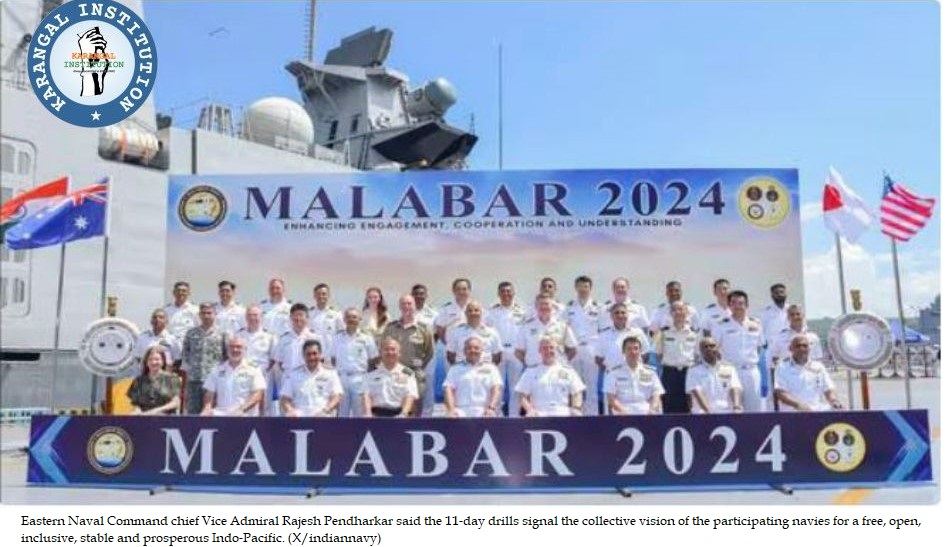The first edition of Malabar took place in 1992 as a bilateral exercise between India and the US; and it has since evolved into a multilateral construct
NEW DELHI: Eastern Naval Command chief Vice Admiral Rajesh Pendharkar on Wednesday said Exercise Malabar 24, involving the navies of India, the US, Australia and Japan (Quad), has its own strategic significance and implications for the Indo-Pacific region, adding that the 11-day drills seek to promote regional stability and security, and deter potential threats through enhanced interoperability.

“It also aims to signal our collective vision for a free, open, inclusive, stable and prosperous Indo-Pacific, and serves as a visible deterrent against disruptive actions in the maritime domain, thus reinforcing a rules-based order,” the top navy officer said in Visakhapatnam where the exercise began on Tuesday.
Those present included General Yoshihide Yoshida, chief of joint staff, Japan, Admiral Stephen Koehler, commander, US Pacific Fleet, Vice Admiral Katsushi Omachi, commander-in-chief, Japan Self Defense Fleet, and Rear Admiral Chris Smith, commander, Australian Fleet.
The remarks come at a time when China is seeking to expand its footprint in the vast region by setting up military bases, pushing countries to advance its maritime claims and forcing strategic concessions from vulnerable States. These actions have fuelled global concerns about China’s intent.
Illegal, unreported and unregulated (IUU) fishing is also among the challenges in the Indo-Pacific region, and China is under the scanner for such activities.
“As we gather to understand, collaborate and engage, we recognise that the Indian Ocean Region, and the broader Indo-Pacific, are becoming increasingly vital for global security and economic stability. The strategic importance of these waters cannot be overstated, as they are essential for trade, energy security and maritime freedom. Realising this, the exercise aims not only to be a military drill but also embodies our commitment to collaboration among like-minded nations to respond to evolving maritime challenges,” Pendharkar said.

The first edition of Malabar took place in 1992 as a bilateral exercise between India and the US; and it has since evolved into a multilateral construct aimed at enhancing interoperability, fostering mutual understanding, and addressing shared maritime challenges.
“It builds upon the cooperation that we have pursued through forums such as the Western Pacific Naval Symposium, the RIMPAC (Rim of the Pacific) exercises, Exercise Milan and the outreach through the SAGAR (Security and Growth for All in the Region) initiative,” he said.
The exercise will feature various Indian naval platforms, including guided missile destroyers, multi-purpose frigates, submarines, fighter aircraft and helicopters. While Australia will deploy HMAS Stuart, an Anzac-class frigate with its MH-60R helicopter, and a P-8 maritime patrol aircraft, the US Navy will field the USS Dewey, an Arleigh Burke-class destroyer with its integral helicopter, and a P-8 maritime patrol aircraft. Japan is taking part in the drills with JS Ariake, a Murasame-class destroyer. Over the years, Malabar increased in its scope and complexity.
“Each edition has built upon the lessons learnt from previous editions, incorporating widening domains, advancing tactics, and a broader range of operational scenarios. This progression is reflective of our increasing comfort in operating with each other and addressing the ever-evolving nature of maritime threats, which necessitate a collaborative and agile approach to naval operations,” Pendharkar said.
The exercise will be among the most advanced of all its editions, featuring complex operational scenarios, and covering all domains of naval warfare, he said. “Ships, submarines, helicopters and aircraft from the participating nations will be operating in proximity, seamlessly exchanging information and undertaking realistic exercises that will challenge the capabilities and readiness of the participating navies. Together, we will strive to share best practices and enhance our combined capabilities to conduct complex operations,” he added.








